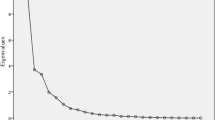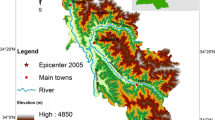Abstract
Most mineral resources in China are located in the areas with fragile geologic environment, where long-term irrational exploitation of mineral resources has caused serious eco-geological environment problems in mining areas as well as their surrounding areas. Hence, it is of great significance to carry out eco-geological environment security assessment for ecological environment protection of mining area. Nevertheless, up to now, effective methods were still quite rare in the field of eco-geological environment security assessment on mining areas. With a focus on the serious ecological environment and geological environment of the Panxi mining area in China, based on GIS and RS, an indicator system and a method with catastrophe theory and the principal component analysis were constructed for evaluating eco-geological environment security of the mining areas; then, validation was carried out for proving their efficiency. The results indicated that, considering natural and human factors, the method eliminated the correlation between various variables and was capable of evaluating the eco-geological environment security in mining areas quantitatively and objectively. Comparing to the existed methods, the proposed method overcame the shortages of the commonly used “index × weight” method, which causing the same contribution of the indicator in different periods for eco-geological environment security. Our method eliminated the “weight” influence on the result and was especially suitable for studying the long time series of the eco-geological environment security assessment and the analysis of driving factors. Besides, the status of the eco-geological environment security in the study area was mainly in safe or relatively safe. The distribution of mild and severe warning areas was limited. The distribution of unsafety areas was small but concentrated in the mining concentrated area within the study area.









Similar content being viewed by others
References
Bortoloti, F. D., Junior, R. C., Araújo, L. C., & Morais, M. G. B. (2015). Preliminary landslide susceptibility zonation using GIS-based fuzzy logic in Vitória, Brazil. Environmental earth Sciences, 74(3), 2125–2141.
Chu, Chunjie, Song, Lisheng, & Liu, Jinxin. (2010). Assessment of Landuse Impacts on Ecological Environment in Buffer Zone of Baiguishan Reservoir. Bulletin of Soil and Water Conservation, 30(5), 206–211.
Cicirello, A., & Langley, R. S. (2014). Modelling the shock induced failure of printed circuit boards. In EURODYN 2014: IX international conference on structural dynamics (pp. 3251–3258).
Collie, J. S., Richardson, K., & Steele, J. H. (2004). Regime shifts: can ecological theory illuminate the mechanisms? Progress in Oceanography, 60(2–4), 281–302.
Deng, L., Hou, D., Wang, C., Zhang, S., & Xia, J. (2003). Study on characteristics of erodibility of natural soil and non-irrigated soil of Sichuan. Soil and Water Conservation in China, 7, 23–25.
Ding, Q. (2019). Let the damaged mountains and rivers return to life—Focus on the 2018 National Mine Ecological Restoration Summit Forum. Land & Resources, 211(02), 30–33.
Du, F., & Gun, W. (2018). Stability analysis on boundary pillar during open-pit to underground mining based on catastrophe theory. Chinese Journal of Underground Space and Engineering, 14(2), 552–557.
Feng, Q., & Liu, Q. (2017). Pre-assessment for the loss caused by storm surge based on the SVM-BP neural network. Marine Environmental Science, 36(4), 615–621.
Gao, C., Cheng, J., & Chen, X. (2016). Application of grey correlation method in evaluation soil and water conservation ecological security in Beijing mountainous area. Journal of Natural Disaster, 25(2), 69–77.
GB/T50218—2014. Standard for engineering classification of rock mass. Beijing: Planning Press.
Guo, Q., Zhang, H., & Liu, H. (2017). Comprehensive evaluation of the geological environment in banding mine based on fuzzy analytic hierarchy process. Metal Mine, 8, 193–198.
Gurioli, L., Sulpizio, R., Cioni, R., Sbrana, A., Santacroce, R., Luperini, W., et al. (2010). Pyroclastic flow hazard assessment at Somma-Vesuvius based on the geological record. Bulletin of Volcanology, 72(9), 1021–1038.
Holmberg, J., Lundqvist, U., Robèrt, K. H., & Wackernagel, M. (1999). The ecological footprint from a systems perspective of sustainability. International Journal of Sustainable Development and World Ecology, 6(1), 17–33.
Hu, J., Fu, L., & Ma, F. (2018). Voltage stability analysis of isolated power system based on catastrophe theory. Transactions of China Electrotechnical Society, 3(20), 213–221.
Hu, B., Zhang, F., Chen, Li, & Zhang, J. (2016). Status and prospect evaluation of mine geological environment research. Earth and Environment, 43(03), 375–378.
Jia, J., & Dong, M. (2018). Fire risk probability evaluation for the grandiose shopping malls based on the catastrophe progression method. Journal of Safety and Environment, 18(1), 61–65.
Kamil, F., & Ahmed, S. (2017). Improving the accuracy of urban environmental quality assessment using geographically-weighted regression techniques. Sensors, 17(3), 528.
Li, J., & Guo, Y. H. (2002). Principal Component evaluation—A multivariate evaluate method expanded from principal component analysis. Journal of Industrial Engineering and Engineering Management, 16(1), 39–43.
Li, D., Han, S., Yi, S., & Zhang, Y. (2017). Ecological risk assessment of land use planning based on PSR model and catastrophe theory: A case study of Guangzhou City. Jiangsu Agricultural Sciences, 45(11), 230–233.
Li, J., & Yuan, W. (2017). Assessment of urban land ecological security in Yinchuan City based on the grid method. Journal of Natural Resources, 32(6), 988–1001.
Liang, G., Xu, W., He, Y., & Zhao, Y. (2008). Application of catastrophe progression method to comprehensive evaluation of slope stability. Rock and Soil Mechanics, 29(7), 1895–1899.
Liu, X., Chen, S., Jiang, C., Hu, J., & Zhang, L. (2014). Vulnerability assessment of coastal erosion along the Abandoned Yellow River Delta of northern Jiangsu, China. Acta Geographica Sinica, 69(5), 607–618.
Liu, L., Guan, D., Yang, Q., & Su, W. (2017). Assessment of water resources security in karst area based on artificial neural network. Bulletin of Soil and Water Conservation, 37(2), 207–214.
Long, Q., Hu, L., Zhang, J., & Zhou, Z. (2015). Traffic incident detection based on the cusp catastrophe theory model. China Civil Engineering Journal, 48(9), 112–116.
Lv, S., Zhao, W., Su, W., & Li, W. (2017). Research on demarcation and distribution features of fringe area of the town in Karst mountainous area. Science of Surveying and Mapping, 42(8), 161–167.
Meng, X., Hou, H., & Wu, S. (2018). Discussion on “green” thoughts in the development of mining industry. China Mining Magazine, 252(08), 88–90.
Nguyen, K. A., Liou, Y. A., & Ming-Hsu, L. (2016). Spatial-temporal eco-environmental vulnerability assessment and its influential factors based on Landsat data. In 2016 AGU Fall Meeting. AGU.
Ni, J., Ding, F., & Yu, H. (2015). Catastrophe theory-based water quality evaluation model under uncertain environment, case in Chaohu Lake. In Proceedings of the ninth international conference on management science and engineering management (pp. 903–916). Berlin Heidelberg: Springer.
Peng, J., Dang, W., Liu, Y., Zong, M., & Hu, X. (2015). Review on landscape ecological risk assessment. Acta Geographica Sinica, 70(4), 664–677.
Piyaratne, M. K. D. K., Zhao, H., & Meng, Q. (2013). APHIDSim: A population dynamics model for wheat aphids based on swallowtail catastrophe theory. Ecological Modelling, 253, 9–16.
Poston, T. (1979). The elements of catastrophe theory or the Honing of Occam’s Razor. Transformations Mathematical Approaches to Culture Change, 18, 425–436.
Shang, H., Ni, W., & Wang, H. (2011). Comprehensive evaluation of mining geo-environment in Shizuishan. Journal of Xi’an University of Science and Technology, 31(6), 836–841.
Shao, H. (2009). Remote sensing information extraction of ecological environment and eco-security evaluation in Panxi mining concentrated area. Doctoral dissertation, Chengdu: Chengdu University of Technology.
Shao, H., Sun, X., Wang, H., Zhang, X., Xiang, Z., Tan, R., et al. (2016). A method to the impact assessment of the returning grazing land to grassland project on regional eco-environmental vulnerability. Environmental Impact Assessment Review, 56, 155–167.
Shao, H., Wu, J., Liu, M., & Yang, W. (2014). Responses of vegetation changes to climatic variations in Panxi area based on the MODIS multispectral data. Spectroscopy and Spectral Analysis, 34(1), 167–171.
Song, L., Liu, T., & Li, E. (2015). Study on prediction of water-inrush of mining goaf based on catastrophe theory. Modern Mining, 5, 121–123.
Sun, Q., Song, G., & Qi, M. (2012). Analysis of land ecological safety evaluation of Harbin City based on principal component analysis. Research of Soil and Water Conservation, 19(1), 238–242.
Wang, H. (2011). The early warning study of our country’s stock market bubble. Doctoral dissertation, Qingdao: Ocean University of China.
Wang, B., Ding, M., Guan, Q., & Ai, J. (2019). Gridded assessment of eco-environmental vulnerability in Nanchang city. Acta Ecologica Sinica, 39(15), 5460–5472.
Wu, Y., Li, Y., Zhang, L., Guo, L., Li, H., Xi, B., et al. (2017). Assessment of lakes ecosystem health based on objective and subjective weighting combined with fuzzy comprehensive evaluation. Journal of Lake Sciences, 29(5), 1091–1102.
Wu, S., & Zhang, Y. (2019). Distribution and management policy of energy resource bases in China. Engineering Sciences, 21(1), 81–87.
Wu, Y., Zhao, X., Xi, Y., Liu, H., & Li, C. (2019). Comprehensive evaluation and spatial-temporal changes of eco-environmental quality based on MODIS in Tibet during 2006–2016. Acta Geographica Sinica, 74(7), 1438–1449.
Xian, W., Shao, H., Wu, J., Liu, M., & Sun, X. (2016). The simulation of mine solid waste generation in Panzhihua City based on system dynamics. International Journal of Environment and Pollution, 59(2–4), 213–229.
Xu, L., Kang, P., & Liu, R. Z. (2013). Dynamic evaluation on environmental carrying capacity of industrial park with catastrophe progression method. China Environmental Science, 33(6), 1127–1136.
Xu, M., Zhu, X., & Liu, C. (2012). Early-warning of land ecological security in Hunan Province based on RBF. Acta Geographica Sinica, 67(10), 1411–1422.
Zeeman, E. C. (1977). Catastrophe theory: Selected papers, 1972–77, 675 pp. Reading, MA: Addison-Wesley. Address: Columbia University/UNES and Society (CUBES) and Urban B.
Zhang, F. (2009). Study on ecological environment compensation mechanism based on negative effect in mining. China Industrial Economics, 12, 30–33.
Zhang, C., Zhang, L., Li, S., & Zhang, C. (2015). Soil conservation of national key ecological function areas. Journal of Resources and Ecology, 6(6), 397–404.
Zhang, H., Zhang, Y., Tian, M., & Wu, C. (2018). Dynamic monitoring of eco-environment quality changes based on PCA: A case study of urban area of Baoji City. Remote Sensing for Land & Resources, 30(1), 203–209.
Zheng, R., Liu, Y., Dong, Y., & Zhu, G. (2009). Appraisal of land resources security in Guangzhou based on major function regionalization. Acta Geocgraphica Sinica, 64(6), 654–664.
Zhu, S., Lin, L., Wu, Y., & Zhang, J. (2016). Application of the matter-element extension method to the ecosystem health assessment of the wetland—A case study on Hengshui Lake wetland national natural reserve. Journal of Safety and Environment, 16(1), 348–353.
Acknowledgments
This study was supported by National Science Foundation of China (Grant No. 41302282), and Science and Technology Program of Sichuan Province (Grant No. 20ZDYF1142).
Author information
Authors and Affiliations
Corresponding author
Rights and permissions
About this article
Cite this article
Sun, X., Shao, H., Xiang, X. et al. A Coupling Method for Eco-Geological Environmental Safety Assessment in Mining Areas Using PCA and Catastrophe Theory. Nat Resour Res 29, 4133–4148 (2020). https://doi.org/10.1007/s11053-020-09682-8
Received:
Accepted:
Published:
Issue Date:
DOI: https://doi.org/10.1007/s11053-020-09682-8




